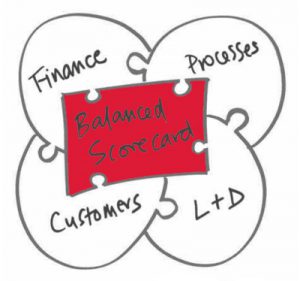On Monday we talked about the origins of the Balanced Scorecard approach, the strategy performance management tool first introduced by Kaplan and Norton in the mid-90s. In today’s post, we’re focusing on the perspectives and implementation of that approach.
A Balanced Scorecard approach generally has four perspectives:
- Financial
- Internal business processes
- Learning & Growth (human focus, or learning and development)
- Customer
Each of the four perspectives is then inter-dependent, meaning that improvement in one area is not necessarily a recipe for success in the other areas.
Implementing a Balanced Scorecard approach
Implementing a Balanced Scorecard system across your company should be the key to the successful realisation of your strategic vision.
This should then result in:
- Improved processes
- Motivated/educated employees
- Enhanced information systems
- Monitored progress
- Greater customer satisfaction
- Increased financial usage
There are scores of software packages available on the market that claim to support the usage of Balanced Scorecard system. Before you go ahead and purchase one, ensure you consider the following:
- Is the software compliant with your current technology platform?
- Is it always accessible to everyone – everywhere?
- Is it easy to understand/update/communicate?
It will be of no use to anyone if only the senior management keep the objectives hidden away. Continuous feedback is an essential part of the process and should be contributed to by everyone within the organisation.
And bear in mind that Balanced Scorecards do not necessarily enable better decision-making!
If you’re looking for more information on Balanced Scorecards, then head to the Wikipedia page.

